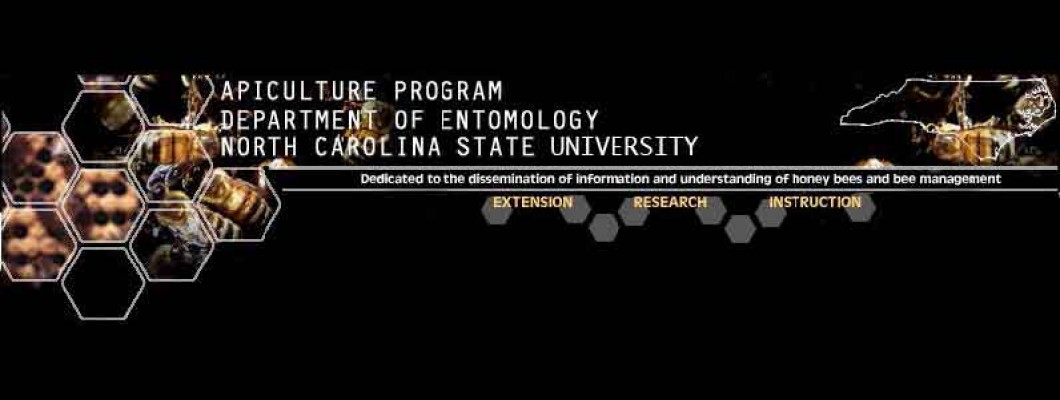
Beekeeping Note 2.15 - 01/2004
Some beekeepers enjoy solitude, working their colonies in the privacy of a tucked away apiary drawing no attention to their pastime. Other beekeepers, however, enjoy sharing their love of bees with others. One of the most powerful and effective means of making a connection with others about the wondrous aspects of honey bee biology and management is by using glass-walled observation hives. Here are some tips on
effectively establishing observation hives.
Step 1: Get good equipment
Presenting your bees begins with owning a top notch observation hive. This includes having an aesthetically pleasing wood, clean and uncracked glass, and appealing fixtures such as latches, handles, and screws. One popular type of observation hive will fit one deep frame, typically for brood, and one shallow frame, typically for honey. (Schematics for this observation hive can be obtained from Beekeeping Note 2.08). Larger observation hives can also be constructed with two,
three, four, or more frames per hive. The size of the hive depends on its function. Larger hives are better suited for more long-term purposes such as research experiments or a permanent display. On the other hand, smaller observation hives are ideal for quick day trips to schools for teaching purposes.
Step 2: Setting up the source colonies
Setting up a successful observation hive takes some planning. If you simply run out to your bee yard and pick a colony at random, you may find yourself
hopelessly searching for the queen or for adequate frames to place in the observation hive. With a little forethought, one can avoid such frustrations. One of the most effective ways to ensure a quick and high-quality observation hive is to always maintain a couple of four- or five-frame nucleus colonies separated from your main
apiary. Because of their small size, the queens are easier to find and the various assortments of frames are more readily found, such as those containing brood at all
stages of development, pollen stores, and capped honey. Because of their smaller size, quickly outgrow the confining space. Thus by swapping frames of brood with foundation and removing excess workers, one can easily maintain healthy and strong nucleus colonies to use for observation
hives.
Step 3: Establishing the observation hive
It is best to establish an observation hive at least one day prior to its use (although such time is not always granted). With sufficient time, the colony will be in a state of equilibrium rather than temporary turmoil, and thus make for a better display. The first course of action is to move the source hive from its position and replace it with either another hive or a dummy hive to catch returning foragers. This will effectively remove many of the foragers from the colony so that the bees used in the observation hive are largely young nurse bees, resulting in an observation hive with fewer workers trying in vain to exit the colony. After 30 minutes or more in this state, one can then transfer the frames and bees into the observation hive itself. Of course, finding the queen is the first order of business; pluck her from the combs and temporarily store her in a queen cage. This is a great opportunity to mark the queen, preferably with a white or yellow mark to make her easier to spot for those with an untrained eye. Once the queen has been secured, it is then necessary to go through the colony frame by frame, choosing a well-covered frame of brood, ideally showing all stages of development (from eggs to larvae to capped pupae) in a nice pattern. A second frame, if necessary, can contain brood and pollen, but usually contains empty space bounded by capped honey.
Taking the glass off one side of the observation hive, you then gently insert the frames from the bottom up, taking care not to push the frame too far, crushing the bees against the glass on the opposite side. Working from the bottom frame upwards helps to avoid frames from pushing against each other and crushing the bees. Prior to inserting the frames, it the top, bottom, and side bars so that the frames fit comfortably within the space provided. Once all frames are in position, you then place the queen into the colony, ideally waiting to put the glass wall over the combs until she has run to the backside of one of the frames. After the final plane of glass is secured, brush off all of the bees from the surface and move the observation hive indoors to a dark cool place for several minutes. This will accomplish two things: (1) it will calm the bees down, and (2) you can more easily find any significant bee leaks in the wood or glass.
Step 4: Transportation
Small observation hives can be transported relatively easily. In fact, some of the smaller, commercially available observation hives come with shoulder straps for easy carrying. Larger observation hives, however, must be transported with care to avoid rocking, overheating, or—the worst case scenario—tipping over and breaking the glass, releasing the bees. Depending on the size and number of observation hives, one may come up with any number of ways to secure the colonies and ensure their safety. One method I prefer is to affix a plank of plywood in the back of my truck and secure the observation hives to it with several screws. I then minimize rocking and tipping by placing hive bodies on either side and securing a strap over top. Depending on how long the bees are in transit, you may need to feed them a 1:1 sugar solution, or ‘syrup’. Feeding them is particularly important if they must endure high temperatures for a long duration (one hour or more), since they can use the liquid to regulate the temperature within the hive by evaporative cooling. The syrup will also convince them that a nectar flow is on, making them less agitated. Another requirement is to provide a method to cover the glass to protect it from direct sunlight from curious eyes before it is time to unveil the bees.
Step 5: Breaking down the observation hive
After your demonstration, it is important to take care of the colony. One option is to place the observation hive in a shaded corner of your apiary, open the entrance, and provide the workers a chance to exit the colony and take short orientation flights to learn their new location. This is particularly useful if you know that you will use the observation hive within the next few days, sparing you the effort of creating another one from scratch. More typically, however, you will return the frames and bees to its colony of origin. If apart for a short time, you can unite the two units directly; if apart for the better part of a week, you may need to unite them using the “newspaper method” (see Caron, 1999). In any event, it is important to inspect the queenless unit for any constructed queen cells and destroy them, otherwise you may lose your marked queen. Be sure to clean up your hive before you store it. This includes scraping any wax from the inside of the glass with razor blades and cleaning the surface with glass cleaner. A clean observation hive in storage will save you from having to clean it the next time you set up your observation colony, hopefully
sooner rather than later.
Further readings
Ambrose, J. T. (1979). Diagram of a single frame observation hive. Beekeeping Note 2.08 (formerly
note #9B). NC State University, Cooperative Extension Service.
Caron, D. M. (1994). Bees in the classroom. American Bee Journal 134: 600-602.
Caron, D. M. (1999). Honey Bee Biology and Beekeeping. Wicwas Press, Cheshire. pp. 355.
Goolsbey, A. (1997). A six-frame observation hive. American Bee Journal 137: 767-767.
Horr, B. Z. (1999). Do-it-yourself - Super observation hive. American Bee Journal 139: 613-616.
Stevenson, H. R. (1985). Establish an observation hive and promote beekeeping. American Bee Journal
125: 89-90.
Vikla, E. E. (1996). How to keep an observation hive through the winter and into spring. American Bee
Journal 136: 101-103.
Watson, B. J. (1998). An observation hive for schools. American Bee Journal 138: 721-723.

